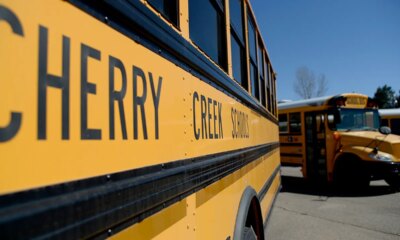Washington, D.C
John Barrasso accuses Deb Haaland of ‘political sympathy’ with pro-Hamas vandals who damaged DC

A Republican senator has charged President Biden’s interior secretary with showing “political sympathy” for pro-Hamas vandals by not cracking down on thousands of demonstrators who descended on the White House last weekend and marred monuments in the nation’s capital.
John Barrasso (R-Wyo.), the ranking member of the Senate Energy and Natural Resources Committee, told Interior Secretary Deb Haaland in a Thursday letter he was “deeply troubled” by the “clear acts of violence and vandalism” committed by “pro-terror, anti-Israel agitators.”
“Disturbingly, police reported no arrests following protesters’ clear acts of violence and vandalism, leaving many questions unanswered about the adequacy of the response to this incident,” he told Haaland.
“I question whether political sympathy with the agitators influenced your department’s response to these acts of violence and vandalism.”
Thousands of jihadi supporters defaced statues of the French military leaders Comte de Rochambeau and Marquis de Lafayette, who aided the Continental Army and George Washington in defeating the British during the Revolutionary War.
Another statue of former US President Andrew Jackson was also vandalized after almost being toppled by demonstrators four years before during rioting following the death of George Floyd.
“Death to AmeriKKKa” the protesters scrawled on the statues, along with “Long live Hamas” and “Muslims 4 Hamas.”
Additional fencing had been erected by federal authorities to protect the executive mansion ahead of the demonstration.
President Biden was not in Washington at the time, but was in France for commemorations of the 80th anniversary of D-Day.
Neither the Metropolitan Police Department nor the US Secret Service reported any arrests in the immediate aftermath, according to the Washington Free Beacon and the Washington Post.
The National Park Service (NPS) has also not yet assessed the total damages to monuments and other property.
A spokesperson for Metro Police confirmed on Friday that “no arrests” had been made “related to the protests near the White House.”
The National Park Service and Secret Service did not immediately respond to requests for comment.
One of the groups organizing the protest, the ANSWER Coalition, accused Biden of crossing a “red line” by allowing Israel to invade Rafah, the last stronghold of Hamas, and called for an immediate cease-fire and end to US funding for Israel’s war against the terror group.
Biden, 81, paused a weapons shipment to Israel and administration officials have pushed for a cease-fire — while Israeli Prime Minister Benjamin Netanyahu has stood firm on the need to eliminate Hamas from Gaza before concluding the war.
The wartime decisions come as the president faces an uphill battle to re-election in 2024, with tens of thousands of “uncommitted” voters in battleground states opposing him over his administration’s support for Israel.
Also on Thursday, Sen. Tom Cotton (R-Ark.) introduced a bill to enforce mandatory minimum prison sentences on vandals who mar statues and destroy other federal property.
“These overt criminal acts, committed on your watch, necessitate your unequivocal condemnation and decisive action to help bring these agitators to justice,” Barrasso scolded Haaland in his letter.
“As the Secretary of the Interior, your support of the [US Park Police] and National Park Service is paramount to the security of our federal lands,” he said. “The brazen assaults and subsequent vandalism are stark reminders of the vulnerabilities faced by law enforcement officers and rangers who serve and protect our national treasures.”
“Your strong and immediate response is essential in affirming our national commitment to the rule of law and the safety of our federal personnel and properties,” the Republican added.
Barrasso has asked for the Interior Department to answer questions about its coordination with other local and federal law enforcement departments to hold the vandals accountable and ensure the future safety of park rangers — at least one of whom was assaulted during the protest.
When offered the opportunity to respond to Barrasso Friday, an Interior Department spokesperson told The Post: “No, thank you.”

Washington, D.C
Virginia Lawmakers Raise Safety Concerns Over Aircraft Safety After Fatal D.C. Crash

WASHINGTON, D.C. (WAVY) — On Dec. 10, U.S. Reps. Don Beyer, Suhas Subramanyam, James Walkinshaw, Bobby Scott, Jennifer McClellan and Eugene Vindman, members of Virginia’s congressional delegation, issued a statement regarding Section 373 of the National Defense Authorization Act for fiscal year 2026.
The section addresses manned rotary-wing aircraft safety in the wake of the Jan. 29, 2025, midair collision at Ronald Reagan Washington National Airport that killed 67 people.
The lawmakers said they share concerns raised by the Families of Flight 5342 and the National Transportation Safety Board over Section 373 of the National Defense Authorization Act, citing safety risks in the airspace around Reagan National Airport following January’s fatal collision.
Congress said the provision allows waivers for training flights that could further congest already crowded airspace.
Congress stated, “This provision falls short of NTSB’s preliminary safety recommendations and omits changes that are essential to improve visibility, safety and communications between military and civilian aircraft in D.C. airspace. Further action is needed to prevent a repetition of the mistakes that led to this incident. We will continue working as quickly as possible with our colleagues and transportation officials to get this right before any waivers are issued and to ensure air safety in the region.”
Washington, D.C
Week Ahead in Washington: December 21

WASHINGTON (Gray DC) – With Congress in recess and President Donald Trump spending the holidays in Florida, attention has turned to the Epstein files and unresolved healthcare legislation.
The trove of documents partly released Friday has prompted some members of Congress to question whether the Department of Justice followed the law requiring their release, as many files were heavily redacted.
California Democratic Rep. Ro Khanna said Friday night he and Kentucky Republican Rep. Thomas Massie were considering drafting articles of impeachment against Attorney General Pam Bondi for not complying with the law the two authored earlier this year.
Deputy Attorney General Todd Blanche said Sunday on NBC’s “Meet the Press” some photos were held back at the request of victim advocacy groups as the DOJ looks at whether they need redactions to protect the victims.
With Congress gone, there remains no solution on healthcare. Enhanced Affordable Care Act tax credits are set to expire at the end of 2025.
Despite enough lawmakers signing onto a discharge petition forcing a vote to extend the subsidies, House Speaker Mike Johnson (R-La.) sent the House home without holding a vote.
Johnson said the full House will vote on the bill when Congress returns to Washington in early January, after the subsidies have lapsed.
Federal workers will get some extra time off this week. Trump signed an executive order closing federal agencies and offices on both Dec. 24 and 26, in addition to Christmas Day.
Copyright 2025 Gray DC. All rights reserved.
Washington, D.C
Smith, Bowser respond to congressional panel accusing D.C. leaders of manipulating crime data

By Michael Kunzelman
Metropolitan Police Department Chief Pamela Smith and D.C. Mayor Muriel Bowser are responding to allegations about the manipulation of crime data in the District.
A Republican-led congressional committee says that the police chief in the nation’s capital pressured subordinates to manipulate department data to artificially lower the city’s crime rates, according to a report by a Republican-led congressional committee.
The report, released Dec. 14 by the House Committee on Oversight and Government Reform, says that the police chief often threatened, punished and retaliated against police commanders who presented her with “spikes in crime.”
A separate investigation by U.S. Attorney Jeanine Pirro’s office also found that a significant number of MPD reports had been misclassified to make crime rates appear lower than they are.
Pirro’s office began its investigation in August at the height of a political showdown between Republican President Donald Trump’s administration and the city over control of the police department. Trump claimed violent crime in Washington was getting worse as he ordered a federal takeover of the police department,
Neither investigation found grounds for charging anybody with a crime.
Smith, who is stepping down at the end of the year after two years in charge of the department, has said she doesn’t believe any crime numbers were manipulated during her tenure.
“I have never and will never authorize or even support any thought processes or activities with regards to crime numbers being manipulated,” she told Fox 5 during an interview earlier this month.
Mayor Bowser on Dec. 15 defended Smith’s performance and accused the House committee’s leaders of rushing to judgment “in order to serve a politically motivated timeline.”
“It is my expectation that the crime statistics we publish and rely on are accurate and of the highest quality possible,” Bowser, a Democrat, wrote in a letter addressed to the House committee’s chair and ranking member.
Homicides are down 31 percent this year, from 181 in 2024 to 125 with roughly two weeks left in 2025, according to MPD crime data. Bowser said independent data on hospital visits shows a 33 percent drop in firearm injuries for the first 10 months of 2025 compared to the same period of 2024. The mayor accused the committee of cherry-picking critical quotes from commanders without interviewing Smith or any assistant chiefs.
“Even a cursory review of the report reveals its prejudice: of the 22 block quotes presented as complaining about Chief Smith’s management style, 20 of them were made by only two command officials interviewed,” Bowser wrote.
The House committee said its findings are based in part on interviews with the commanders of all seven D.C. patrol districts and a former commander who is currently on leave. Commanders testified that Smith pushed for a more frequent use of “intermediate” criminal charges that go unreported as opposed to more serious charges that must be publicly reported, according to the committee.
“These combined efforts, as explained by commanders, amounted to manipulating MPD crime statistics in an effort to show lowered rates of crime to the public,” the report says.
Pirro, who was appointed by Trump, said her office reviewed nearly 6,000 police reports and interviewed more than 50 witnesses in concluding that a “significant number of reports had been misclassified, making crime appear artificially lower than it was.”
“The uncovering of these manipulated crime statistics makes clear that President Trump has reduced crime even more than originally thought, since crimes were actually higher than reported,” Pirro’s statement says.
The committee’s Republican chairman, Rep. James Comer of Kentucky, said Smith “cultivated a culture of fear to achieve her agenda.”
This article was originally published by The Associated Press.
-

 Iowa1 week ago
Iowa1 week agoAddy Brown motivated to step up in Audi Crooks’ absence vs. UNI
-

 Iowa1 week ago
Iowa1 week agoHow much snow did Iowa get? See Iowa’s latest snowfall totals
-

 Maine6 days ago
Maine6 days agoElementary-aged student killed in school bus crash in southern Maine
-

 Maryland1 week ago
Maryland1 week agoFrigid temperatures to start the week in Maryland
-

 South Dakota1 week ago
South Dakota1 week agoNature: Snow in South Dakota
-

 New Mexico5 days ago
New Mexico5 days agoFamily clarifies why they believe missing New Mexico man is dead
-

 Detroit, MI7 days ago
Detroit, MI7 days ago‘Love being a pedo’: Metro Detroit doctor, attorney, therapist accused in web of child porn chats
-

 Maine5 days ago
Maine5 days agoFamily in Maine host food pantry for deer | Hand Off























